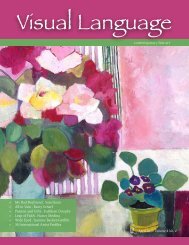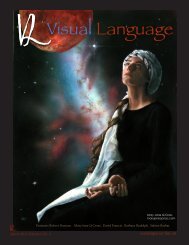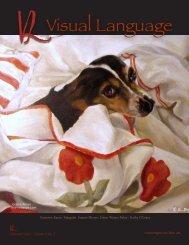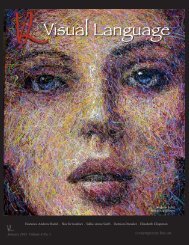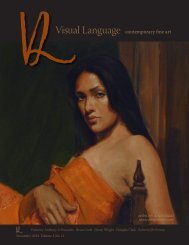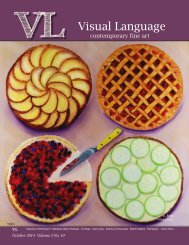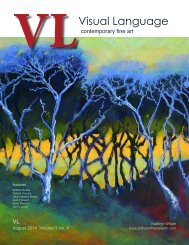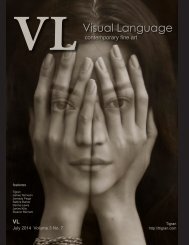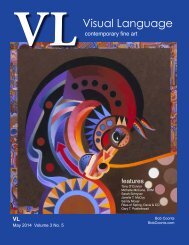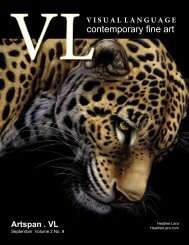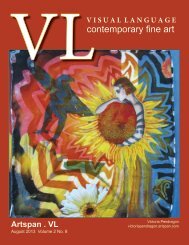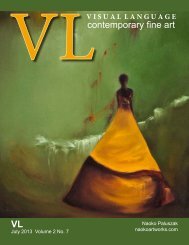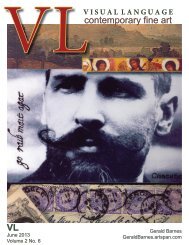Visual Language Visual Language Contemporary Fine Art Vol 2 No 11 November 2013
Visual Language Magazine is a contemporary fine art magazine filled with dynamic international fine art, brilliant colors and stimulating composition. This month features the The Dutch Art Gallery in Dallas, Texas, The Artists of Texas 5th Annual Show, Interview with Hall Groat II, Robert Huckestein, Melissa Post van der Burg and Photographer Romoli Francesco. On the Cover is the artwork of Artspan Artist VL Rees. Visual Language is the common connection around the world for art expressed through every media and process. The artists connect through their creativity to the viewers by both their process as well as their final piece. No interpreters are necessary because Visual Language Magazine crosses all boundaries.
Visual Language Magazine is a contemporary fine art magazine filled with dynamic international fine art, brilliant colors and stimulating composition. This month features the The Dutch Art Gallery in Dallas, Texas, The Artists of Texas 5th Annual Show, Interview with Hall Groat II, Robert Huckestein, Melissa Post van der Burg and Photographer Romoli Francesco. On the Cover is the artwork of Artspan Artist VL Rees. Visual Language is the common connection around the world for art expressed through every media and process. The artists connect through their creativity to the viewers by both their process as well as their final piece. No interpreters are necessary because Visual Language Magazine crosses all boundaries.
Create successful ePaper yourself
Turn your PDF publications into a flip-book with our unique Google optimized e-Paper software.
VL<br />
Studio Visit Robert Huckestein<br />
Born in Pittsburgh, Pennsylvania, I have had art in my blood for as long as I can remember. When<br />
I was a child, I couldn’t wait to get up on Saturday morning, turn on the television, (a new fangled<br />
contraption at the time) pull out my box of John Nagy art supplies that I had sent away for, and begin<br />
that morning’s art project that John Nagy had prepared for his television audience of young, aspiring<br />
artists. That is one of my earliest memories that had me dreaming of becoming an artist some day.<br />
Ever since those Saturday art projects, I have been drawing, painting, and reading about other artists,<br />
both past and present, to help me in my quest to become a professional artist. However, my<br />
art career went in another direction early on because of some well-meaning people, including my<br />
parents, who kept telling me that trying to make a living as an artist was unrealistic. So, I began my<br />
thirty-five year career in the engineering field. Although this career did help me to support my wife,<br />
and to raise two wonderful children, it did put my full time art career on hold. But, it didn’t stop me<br />
from drawing, painting, and studying art history. The years that I spent working in the engineering<br />
field allowed me to visit galleries and museums around the world which helped me to learn about art<br />
and artists in other countries. It also allowed me to use my spare time to improve my drawing and<br />
painting skills, and take painting workshops from a variety of artists in the country.<br />
Fast forward to today, and here I am living my dream as a full time artist. The paintings and drawings<br />
I create are a result of all those years spent honing my artistic skills, and studying techniques of<br />
past artists, as well as contemporary artists of today. My early paintings were experiments of many<br />
different styles from abstract to photorealism. But, I always returned to drawing and painting in a<br />
realistic style of which my work is now recognized for. These realistic paintings and drawings are of<br />
the architecture, and the people of the city and surrounding small towns that are distinct of Western<br />
Pennsylvania. I find these buildings and people are interesting subject matter for my paintings and<br />
drawings.<br />
I have also worked on learning all I could about all the materials that I use in my paintings and<br />
drawings. Some of the materials I use for these paintings are oil and acrylic paint, pastels, and<br />
watercolors. My drawings are done with charcoal and graphite pencils. All the painting, drawing,<br />
and reading I did in the past has helped me to not only improve my own art work, but also prepared<br />
me for the adult classes and work shops that I teach at the Pittsburgh Center for the <strong>Art</strong>s and other<br />
organizations in Pittsburgh.<br />
My work follows a process that begins with an emotional connection to whatever I have chosen to<br />
paint or draw. My early paintings began mostly as studies of the architecture of Pittsburgh, the old<br />
homes and the large buildings that were occupied by many of the businesses and corporations that<br />
made Pittsburgh one of our country’s largest corporate headquarters. People were not part of these<br />
paintings in the beginning, but as time went on, the figure started to manifest itself gradually into the<br />
composition. As my work evolved, I became more and more fascinated with the figure until eventually<br />
the figure took over, and the architecture became just a backdrop for the rest of the composition.<br />
I now use both the figure and the architecture together to make a statement. I’ll use one figure or<br />
a combination of figures in the composition that have a connection to each other, that tells a story,<br />
refers to something in the past, or has a connection to a current event that’s associated with a local<br />
or national news story.<br />
http://www.roberthuckestein.com/<br />
42 | VL Magazine - <strong>Visual</strong><strong>Language</strong>Magazine.com



